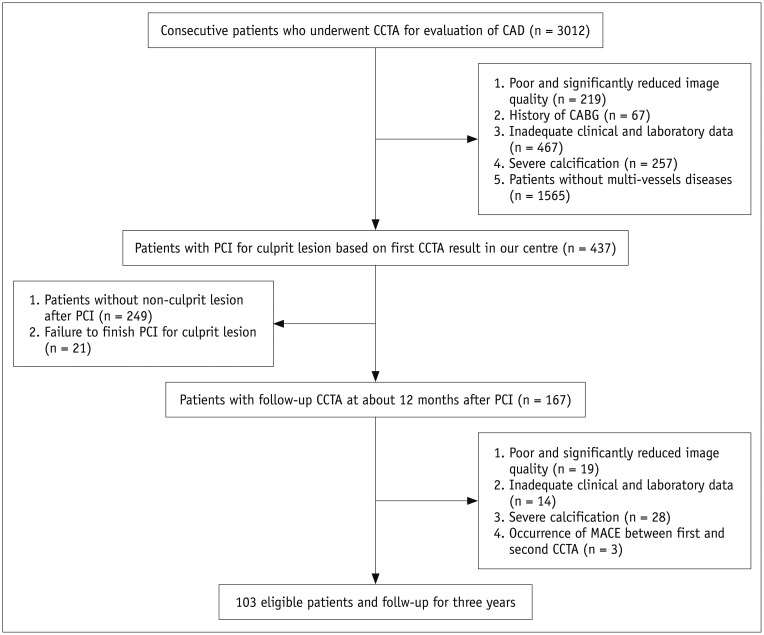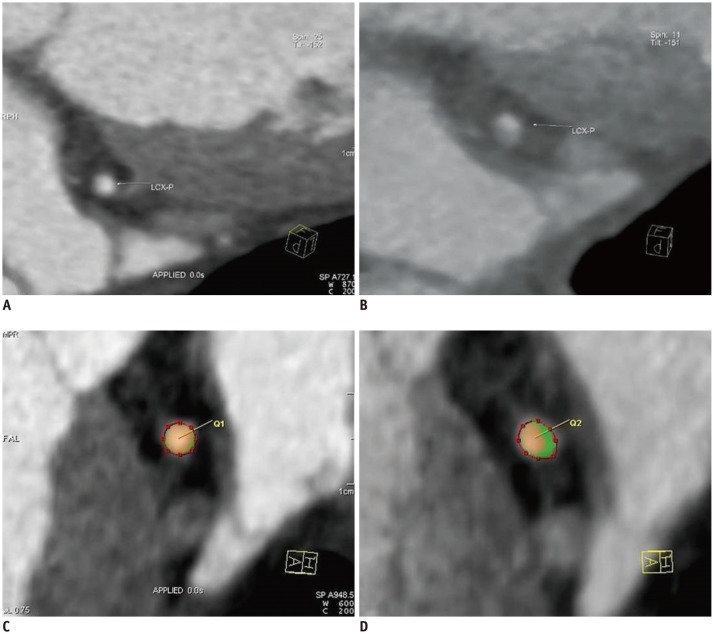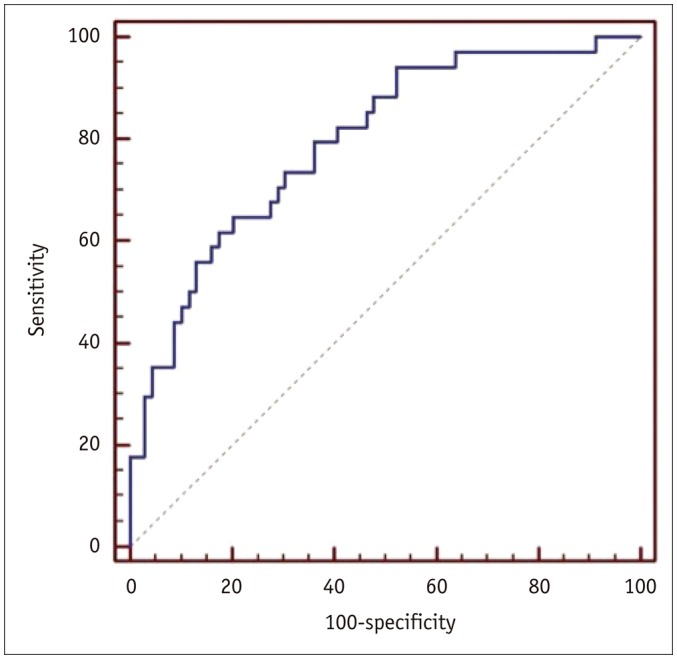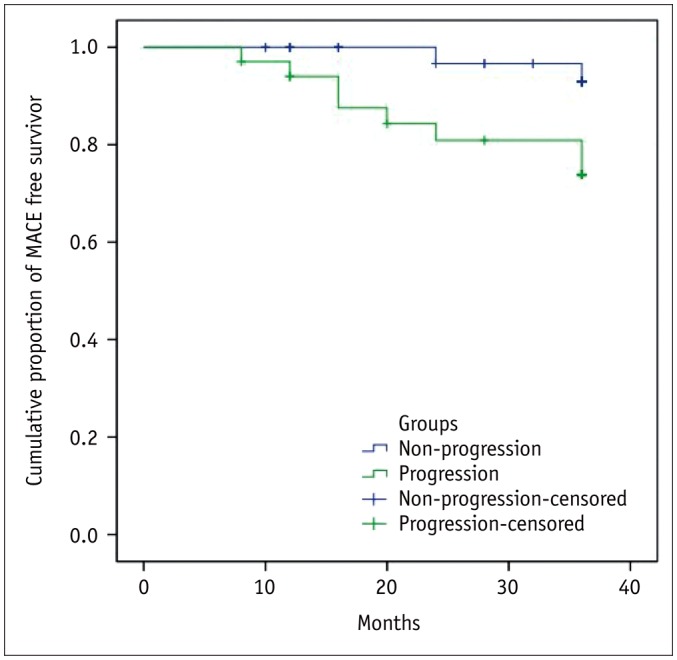Korean J Radiol.
2017 Jun;18(3):487-497. 10.3348/kjr.2017.18.3.487.
Characteristics Detected on Computed Tomography Angiography Predict Coronary Artery Plaque Progression in Non-Culprit Lesions
- Affiliations
-
- 1Department of Cardiology, Chinese PLA General Hospital, Beijing 100853, China. yundaichen@yeah.net
- 2The School of Medicine, Nankai University, Tianjin 300071, China.
- 3Department of Cardiology, Tianjin Chest Hospital, Tianjin 300000, China.
- 4Department of Cardiology, Beijing Shijitan Hospital, Capital Medical University, Beijing 100038, China.
- KMID: 2427304
- DOI: http://doi.org/10.3348/kjr.2017.18.3.487
Abstract
OBJECTIVE
This study sought to determine whether variables detected on coronary computed tomography angiography (CCTA) would predict plaque progression in non-culprit lesions (NCL).
MATERIALS AND METHODS
In this single-center trial, we analyzed 103 consecutive patients who were undergoing CCTA and percutaneous coronary intervention (PCI) for culprit lesions. Follow-up CCTA was scheduled 12 months after the PCI, and all patients were followed for 3 years after their second CCTA examination. High-risk plaque features and epicardial adipose tissue (EAT) volume were assessed by CCTA. Each NCL stenosis grade was compared visually between two CCTA scans to detect plaque progression, and patients were stratified into two groups based on this. Logistic regression analysis was used to evaluate the factors that were independently associated with plaque progression in NCLs. Time-to-event curves were compared using the log-rank statistic.
RESULTS
Overall, 34 of 103 patients exhibited NCL plaque progression (33%). Logistic regression analyses showed that the NCL progression was associated with a history of ST-elevated myocardial infarction (odds ratio [OR] = 5.855, 95% confidence interval [CI] = 1.391-24.635, p = 0.016), follow-up low-density lipoprotein cholesterol level (OR = 6.832, 95% CI = 2.103-22.200, p = 0.001), baseline low-attenuation plaque (OR = 7.311, 95% CI = 1.242-43.028, p = 0.028) and EAT (OR = 1.015, 95% CI = 1.000-1.029, p = 0.044). Following the second CCTA examination, major adverse cardiac events (MACEs) were observed in 12 patients, and NCL plaque progression was significantly associated with future MACEs (log rank p = 0.006).
CONCLUSION
Noninvasive assessment of NCLs by CCTA has potential prognostic value.
Keyword
MeSH Terms
-
Adipose Tissue/diagnostic imaging
Aged
Area Under Curve
Cholesterol, HDL/blood
Cholesterol, LDL/blood
*Computed Tomography Angiography
Coronary Artery Disease/*diagnostic imaging/mortality
Disease Progression
Female
Humans
Kaplan-Meier Estimate
Logistic Models
Male
Middle Aged
Odds Ratio
Percutaneous Coronary Intervention
Plaque, Atherosclerotic/*diagnostic imaging/pathology
Prognosis
ROC Curve
Risk Factors
Triglycerides/blood
Cholesterol, HDL
Cholesterol, LDL
Triglycerides
Figure
Cited by 1 articles
-
Age of Data in Contemporary Research Articles Published in Representative General Radiology Journals
Ji Hun Kang, Dong Hwan Kim, Seong Ho Park, Jung Hwan Baek
Korean J Radiol. 2018;19(6):1172-1178. doi: 10.3348/kjr.2018.19.6.1172.
Reference
-
1. Stone GW, Maehara A, Lansky AJ, de Bruyne B, Cristea E, Mintz GS, et al. A prospective natural-history study of coronary atherosclerosis. N Engl J Med. 2011; 364:226–235. PMID: 21247313.
Article2. Glaser R, Selzer F, Faxon DP, Laskey WK, Cohen HA, Slater J, et al. Clinical progression of incidental, asymptomatic lesions discovered during culprit vessel coronary intervention. Circulation. 2005; 111:143–149. PMID: 15623544.
Article3. Narula J, Kovacic JC. Putting TCFA in clinical perspective. J Am Coll Cardiol. 2014; 64:681–683. PMID: 25125299.
Article4. Motoyama S, Kondo T, Sarai M, Sugiura A, Harigaya H, Sato T, et al. Multislice computed tomographic characteristics of coronary lesions in acute coronary syndromes. J Am Coll Cardiol. 2007; 50:319–326. PMID: 17659199.
Article5. Motoyama S, Sarai M, Harigaya H, Anno H, Inoue K, Hara T, et al. Computed tomographic angiography characteristics of atherosclerotic plaques subsequently resulting in acute coronary syndrome. J Am Coll Cardiol. 2009; 54:49–57. PMID: 19555840.
Article6. Inoue K, Motoyama S, Sarai M, Sato T, Harigaya H, Hara T, et al. Serial coronary CT angiography-verified changes in plaque characteristics as an end point: evaluation of effect of statin intervention. JACC Cardiovasc Imaging. 2010; 3:691–698. PMID: 20633846.7. Motoyama S, Sarai M, Narula J, Ozaki Y. Coronary CT angiography and high-risk plaque morphology. Cardiovasc Interv Ther. 2013; 28:1–8. PMID: 23108779.
Article8. Hajsadeghi F, Nabavi V, Bhandari A, Choi A, Vincent H, Flores F, et al. Increased epicardial adipose tissue is associated with coronary artery disease and major adverse cardiovascular events. Atherosclerosis. 2014; 237:486–489. PMID: 25463078.
Article9. Gibbons RJ, Abrams J, Chatterjee K, Daley J, Deedwania PC, Douglas JS, et al. ACC/AHA 2002 guideline update for the management of patients with chronic stable angina--summary article: a report of the American College of Cardiology/American Heart Association Task Force on practice guidelines (Committee on the Management of Patients with Chronic Stable Angina). J Am Coll Cardiol. 2003; 41:159–168. PMID: 12570960.10. Lee AM, Beaudoin J, Engel LC, Sidhu MS, Abbara S, Brady TJ, et al. Assessment of image quality and radiation dose of prospectively ECG-triggered adaptive dual-source coronary computed tomography angiography (cCTA) with arrhythmia rejection algorithm in systole versus diastole: a retrospective cohort study. Int J Cardiovasc Imaging. 2013; 29:1361–1370. PMID: 23526082.
Article11. Han Y, Jing J, Tu S, Tian F, Xue H, Chen W, et al. ST elevation acute myocardial infarction accelerates non-culprit coronary lesion atherosclerosis. Int J Cardiovasc Imaging. 2014; 30:253–261. PMID: 24420418.
Article12. Xia Y, Junjie Y, Ying Z, Bai H, Qi W, Qinhua J, et al. Accuracy of 128-slice dual-source CT using high-pitch spiral mode for the assessment of coronary stents: first in vivo experience. Eur J Radiol. 2013; 82:617–622. PMID: 23265926.
Article13. Puchner SB, Liu T, Mayrhofer T, Truong QA, Lee H, Fleg JL, et al. High-risk plaque detected on coronary CT angiography predicts acute coronary syndromes independent of significant stenosis in acute chest pain: results from the ROMICAT-II trial. J Am Coll Cardiol. 2014; 64:684–692. PMID: 25125300.14. Ito H, Motoyama S, Sarai M, Kawai H, Harigaya H, Kan S, et al. Characteristics of plaque progression detected by serial coronary computed tomography angiography. Heart Vessels. 2014; 29:743–749. PMID: 24113717.
Article15. Hoffmann U, Moselewski F, Nieman K, Jang IK, Ferencik M, Rahman AM, et al. Noninvasive assessment of plaque morphology and composition in culprit and stable lesions in acute coronary syndrome and stable lesions in stable angina by multidetector computed tomography. J Am Coll Cardiol. 2006; 47:1655–1662. PMID: 16631006.
Article16. Gauss S, Achenbach S, Pflederer T, Schuhbäck A, Daniel WG, Marwan M. Assessment of coronary artery remodelling by dual-source CT: a head-to-head comparison with intravascular ultrasound. Heart. 2011; 97:991–997. PMID: 21478387.
Article17. Kashiwagi M, Tanaka A, Kitabata H, Tsujioka H, Kataiwa H, Komukai K, et al. Feasibility of noninvasive assessment of thin-cap fibroatheroma by multidetector computed tomography. JACC Cardiovasc Imaging. 2009; 2:1412–1419. PMID: 20083077.
Article18. Ueda H, Harimoto K, Tomoyama S, Tamaru H, Miyawaki M, Mitsusada N, et al. Relation of cardiovascular risk factors and angina status to obstructive coronary artery disease according to categorical coronary artery calcium score. Heart Vessels. 2012; 27:128–134. PMID: 21416117.
Article19. Bayturan O, Kapadia S, Nicholls SJ, Tuzcu EM, Shao M, Uno K, et al. Clinical predictors of plaque progression despite very low levels of low-density lipoprotein cholesterol. J Am Coll Cardiol. 2010; 55:2736–2742. PMID: 20538166.
Article20. Rioufol G, Finet G, Ginon I, André-Fouët X, Rossi R, Vialle E, et al. Multiple atherosclerotic plaque rupture in acute coronary syndrome: a three-vessel intravascular ultrasound study. Circulation. 2002; 106:804–808. PMID: 12176951.21. Asakura M, Ueda Y, Yamaguchi O, Adachi T, Hirayama A, Hori M, et al. Extensive development of vulnerable plaques as a pancoronary process in patients with myocardial infarction: an angioscopic study. J Am Coll Cardiol. 2001; 37:1284–1288. PMID: 11300436.
Article22. Guazzi MD, Bussotti M, Grancini L, De Cesare N, Guazzi M, Pera IL, et al. Evidence of multifocal activity of coronary disease in patients with acute myocardial infarction. Circulation. 1997; 96:1145–1151. PMID: 9286942.
Article23. Otsuka K, Fukuda S, Tanaka A, Nakanishi K, Taguchi H, Yoshiyama M, et al. Prognosis of vulnerable plaque on computed tomographic coronary angiography with normal myocardial perfusion image. Eur Heart J Cardiovasc Imaging. 2014; 15:332–340. PMID: 24204033.
Article24. Motoyama S, Ito H, Sarai M, Kondo T, Kawai H, Nagahara Y, et al. Plaque characterization by coronary computed tomography angiography and the likelihood of acute coronary events in mid-term follow-up. J Am Coll Cardiol. 2015; 66:337–346. PMID: 26205589.25. Criqui MH, Denenberg JO, Ix JH, McClelland RL, Wassel CL, Rifkin DE, et al. Calcium density of coronary artery plaque and risk of incident cardiovascular events. JAMA. 2014; 311:271–278. PMID: 24247483.
Article26. Bourantas CV, Garcia-Garcia HM, Farooq V, Maehara A, Xu K, Généreux P, et al. Clinical and angiographic characteristics of patients likely to have vulnerable plaques: analysis from the PROSPECT study. JACC Cardiovasc Imaging. 2013; 6:1263–1272. PMID: 24269259.27. Yun KH, Mintz GS, Farhat N, Marso SP, Taglieri N, Verheye S, et al. Relation between angiographic lesion severity, vulnerable plaque morphology and future adverse cardiac events (from the Providing Regional Observations to Study Predictors of Events in the Coronary Tree study). Am J Cardiol. 2012; 110:471–477. PMID: 22579346.
Article28. Voros S, Rinehart S, Qian Z, Vazquez G, Anderson H, Murrieta L, et al. Prospective validation of standardized, 3-dimensional, quantitative coronary computed tomographic plaque measurements using radiofrequency backscatter intravascular ultrasound as reference standard in intermediate coronary arterial lesions: results from the ATLANTA (assessment of tissue characteristics, lesion morphology, and hemodynamics by angiography with fractional flow reserve, intravascular ultrasound and virtual histology, and noninvasive computed tomography in atherosclerotic plaques) I study. JACC Cardiovasc Interv. 2011; 4:198–208. PMID: 21349459.29. Marwan M, Taher MA, El Meniawy K, Awadallah H, Pflederer T, Schuhbäck A, et al. In vivo CT detection of lipid-rich coronary artery atherosclerotic plaques using quantitative histogram analysis: a head to head comparison with IVUS. Atherosclerosis. 2011; 215:110–115. PMID: 21227419.
Article30. Raggi P. Epicardial adipose tissue and progression of coronary artery calcium: cause and effect or simple association? JACC Cardiovasc Imaging. 2014; 7:917–919. PMID: 25212796.31. Gauss S, Klinghammer L, Steinhoff A, Raaz-Schrauder D, Marwan M, Achenbach S, et al. Association of systemic inflammation with epicardial fat and coronary artery calcification. Inflamm Res. 2015; 64:313–319. PMID: 25763815.
Article32. Mahabadi AA, Lehmann N, Kälsch H, Robens T, Bauer M, Dykun I, et al. Association of epicardial adipose tissue with progression of coronary artery calcification is more pronounced in the early phase of atherosclerosis: results from the Heinz Nixdorf recall study. JACC Cardiovasc Imaging. 2014; 7:909–916. PMID: 25190138.
- Full Text Links
- Actions
-
Cited
- CITED
-
- Close
- Share
- Similar articles
-
- Plaque Characteristics on Coronary CT Angiography: Effects on the Degree of Coronary Artery Stenosis
- Future Directions in Coronary CT Angiography: CT-Fractional Flow Reserve, Plaque Vulnerability, and Quantitative Plaque Assessment
- Plaque Characteristics and Clinical Presentation Associated with Coronary Artery Remodeling: An Intravascular Ultrasound Study
- Serial Changes of Coronary Atherosclerotic Plaque: Assessment with 64-Slice Multi-Detector Computed Tomography
- Evaluation of Atherosclerotic Plaque in Patients without Coronary Artery Calcification Using Multidetector Row Computed Tomography: A Preliminary Report of 110 patients





